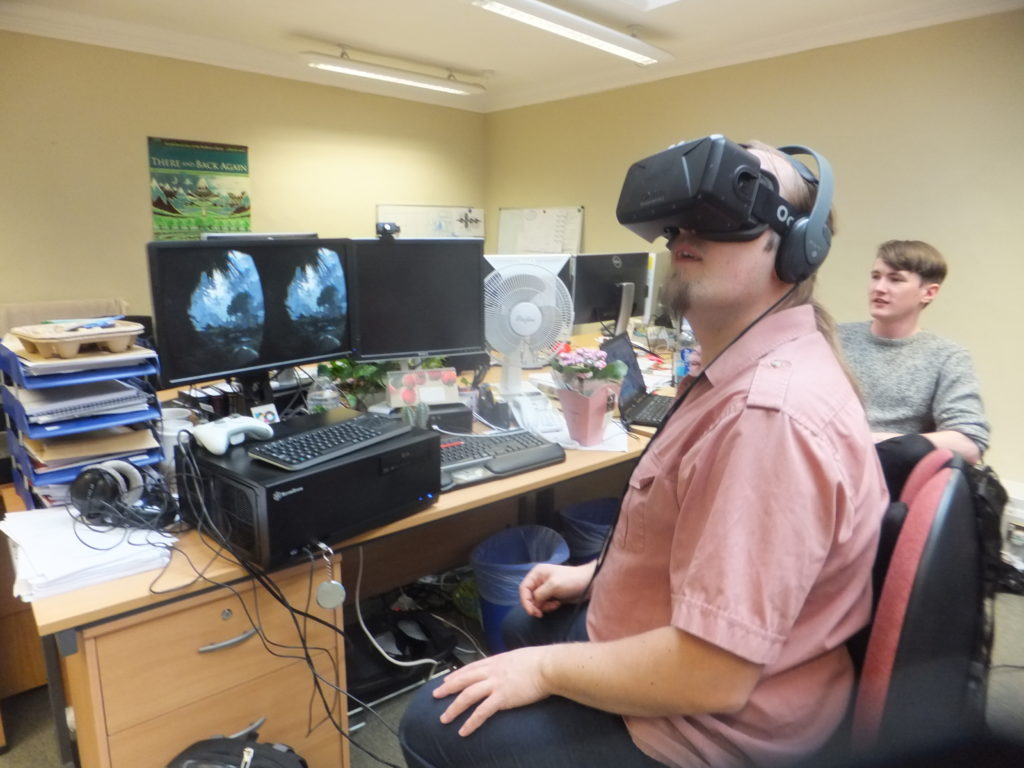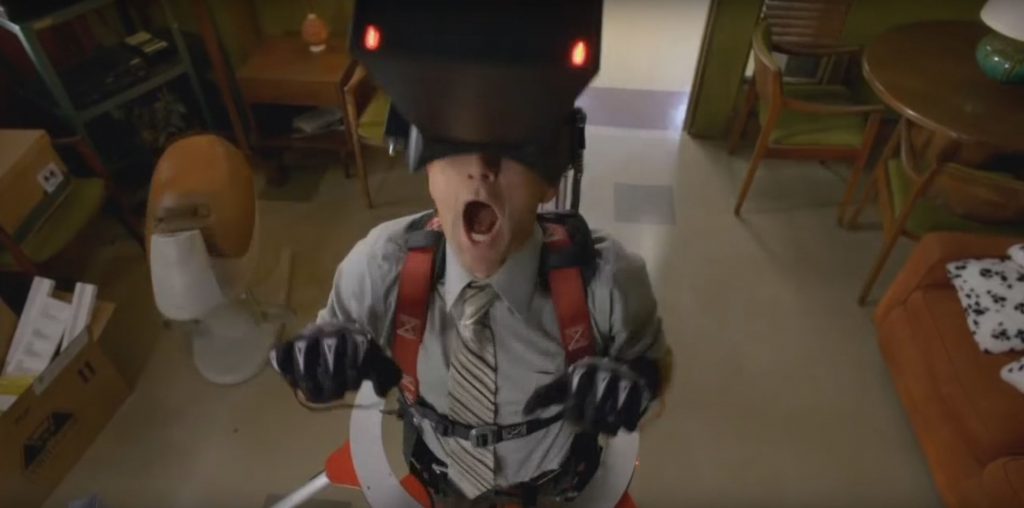Quake
This is a repost promoting content originally published elsewhere. See more things Dan's reposted.
This is a repost promoting content originally published elsewhere. See more things Dan's reposted.
This is a repost promoting content originally published elsewhere. See more things Dan's reposted.
I’ve been happy with my 2016 HTPC, but the situation has changed, largely because of something I mentioned in passing back in November: The Xbox One and PS4 are effectively plain old PCs, built on: Intel Atom class (aka slow) AMD 8-core x86 CPU 8 GB RAM AMD Radeon 77xx / 78xx GPUs cheap commodity…
This is the (long-overdue) last in a three-part blog post about telling stories using virtual reality. Read all of the parts here.
For the first time in two decades, I’ve been playing with virtual reality. This time around, I’ve been using new and upcoming technologies like Google Cardboard and the Oculus Rift. I’m particularly interested in how these new experiences can be used as a storytelling medium by content creators, and the lessons we’ll learn about immersive storytelling by experimenting with them.

It seems to me that the biggest questions that VR content creators will need to start thinking about as we collectively begin to explore this new (or newly-accessible) medium are:
This question mostly relates to creators making “interactive” experiences. Superficially, VR gives user experience designers a running start because there’s little that’s as intuitive as “turning your head to look around” (and, in fact, trying the technology out on a toddler convinced me that it’s adults – who already have an anticipation of what a computer interface ought to be – who are the only ones who’ll find this challenging). On the other hand, most interactive experiences demand more user interaction than simply looking around, and therein lies the challenge. Using a keyboard while you’re wearing a headset is close to impossible (trust me, I’ve tried), although the augmented-reality approach of the Hololens and potentially even the front-facing webcam that’s been added to the HTC Vive PRE might be used to mitigate this. A gamepad is workable, but it’s slightly immersion-breaking in some experiences to hold your hands in a conventional “gamer pose”, as I discovered while playing my Gone Home hackalong: this was the major reason I switched to using a Wiimote.

So far, I’ve seen a few attempts that don’t seem to work, though. The (otherwise) excellent educational solar system exploration tool Titans of Space makes players stare at on-screen buttons for a few seconds to “press” them, which is clunky and unintuitive: in the real world, we don’t press buttons with our eyes! I understand why they’ve done this: they’re ensuring that their software has the absolute minimum interface requirement that’s shared between the platforms that it supports, but that’s a concern too! If content creators plan to target two or more of the competing systems that will launch this year alone, will they have to make usability compromises?
There’s also the question of how we provide ancillary information to players: the long-established paradigms of “health in the bottom left, ammo in the bottom right” don’t work so obviously when they’re hidden in your peripheral vision. Games like Elite Dangerous have tackled this problem from their inception by making a virtualised “real” user interface comprised of the “screens” in the spaceship around you, but it’s an ongoing challenge for titles that target both VR and conventional platforms in future. Wareable made some great observations about these kinds of concerns, too.
In my previous blog post, I talked about a documentary that used 360° cameras to “place” the viewer among the protesters that formed the subject of the documentary. In order to provide some context and to reduce the disorientation experienced by “jumping” from location to location, the creator opted to insert “title slides” between scenes with text explaining what would be seen next. But title slides necessitate that the viewer is looking in a particular direction! In the case of this documentary and several other similar projects I’ve seen, the solution was to put the title in four places – at each of the four cardinal directions – so that no matter which way you were looking you’ll probably be able to find one. But title slides are only a small part of the picture.

Directors producing content – whether interactive or not – for virtual reality will have to think hard about the implications of the fact that their camera (whether a physical camera or – slightly easier and indeed more-controllable – a simulated camera in a 3D-rendered world) can look in any direction. Sets must be designed to be all-encompassing, which poses huge challenges for the traditional methods of producing film and television programmes. Characters’ exits and entrances must be through believable portals: they can’t simply walk off to the left and stop. And, of course, the content creator must find a way to get the audience’s attention when they need it: watching the first few minutes of Backstage with an Elite Ballerina, for example, puts you in a spacious dance studio with a spritely ballerina to follow… but there’s nothing to stop you looking the other way (perhaps by accident), and – if you do – you might miss some of the action or find it difficult to work out where you’re supposed to be looking. Expand that to a complex, busy scene like, say… the ballroom scene in Labyrinth… and you might find yourself feeling completely lost within a matter of minutes (of course, a feeling of being lost might be the emotional response that the director intends, and hey – VR is great for that!).

The potential for VR in some kinds of stories is immense, though. How about a murder mystery story played out in front of you in a dollhouse (showing VR content “in minature” can help with the motion sickness some people feel if they’re “dragged” from scene to scene): you can move your head to peep in to any room and witness the conversations going on, but the murder itself happens during a power cut or otherwise out-of-sight and the surviving characters are left to deduce the clues. In such a (non-interactive) experience the spectator has the option to follow the action in whatever way they like, and perhaps even differently on different playthroughs, putting the focus on the rooms and characters and clues that interest them most… which might affect whether or not they agree with the detective’s assertions at the end…
As I mentioned in the previous blog post, we’ve already seen the evolution of storytelling media on several occasions, such as the jump from theatre to cinema and the opportunities that this change eventually provided. Early screenwriters couldn’t have conceived of some of the tools used in modern films, like the use of long flowing takes for establishing shots or the use of fragmented hand-held shots to add an excited energy to fight scenes. It wasn’t for lack of imagination (Georges Méliès realised back in the nineteenth century that timelapse photography could be used to produce special effects not possible in theatre) but rather a lack of the technology and more-importantly a lack of the maturity of the field. There’s an ongoing artistic process whereby storytellers find new ways to manage their medium from one another: Romeo Must Die may have made clever use of a “zoom-to-X-ray” when a combatant’s bones were broken, but it wouldn’t have been possible if The Matrix hadn’t shown the potential for “bullet time” the previous year. And if we’re going down that road: have you seen the bullet time scene in Zotz!, a film that’s older than the Wachowskis themselves?
Clearly, we’re going to discover new ways of telling stories that aren’t possible with traditional “flat screen” media nor with more-immersive traditional theatre: that’s what makes VR as a storytelling tool so exciting.

Of course, we don’t yet know what storytelling tools we’ll find in this medium, but some ideas I’ve been thinking about are:

![GIF showing a variety people watching VR porn. [SFW]](https://media.giphy.com/media/l41lQODMertvSTIjK/giphy.gif)
As I’m sure I’ve given away these last three blog posts, I’m really interested in the storytelling potential of VR, and you can bet I’ll be bothering you all again with updates of the things I get to play with later this year (and, in fact, some of the cool technologies I’ve managed to get access to just while I’ve been writing up these blog posts).
If you haven’t had a chance to play with contemporary VR, get yourself a cardboard. It’s dirt-cheap and it’s (relatively) low-tech and it’s nowhere near as awesome as “real” hardware solutions… but it’s still a great introduction to what I’m talking about and it’s absolutely worth doing. And if you have, I’d love to hear your thoughts on storytelling using virtual reality, too.
This is the second in a three-part blog post about telling stories using virtual reality. Read all of the parts here.
I’m still waiting to get in on the Oculus Rift and HTC Vive magic when they’re made generally-available, later this year. But for the meantime, I’m enjoying quite how hackable VR technologies are. I chucked my Samsung Galaxy S6 edge into an I Am Cardboard DSCVR, paired it with a gaming PC using TrinusVR, used GlovePIE to hook up a Wii remote (playing games with a keyboard or even a gamepad is challenging if your headset doesn’t have a headstrap, so a one-handed control is needed), and played a game of Gone Home. It’s a cheap and simple way to jump into VR gaming, especially if – like me – you already own the electronic components: the phone, PC, and Wiimote.

While the media seems to mostly fixate on the value of VR in “action” gaming – shoot-’em-ups, flight simulators, etc. – I actually think there’s possibly greater value in it more story-driven genres. I chose Gone Home for my experiment, above, because it’s an adventure that you play at your own pace, where the amount you get out of it as a story depends on your level of attention to detail, not how quickly you can pull a trigger. Especially on this kind of highly-affordable VR gear, “twitchy” experiences that require rapid head turning are particularly unsatisfying, not-least because the response time of even the fastest screens is always going to be significantly slower than that of real life. But as a storytelling medium (especially in an affordable form) it’s got incredible potential.

I was really pleased to discover that some content creators are already experimenting with the storytelling potential of immersive VR experiences. An example would be the video Hong Kong Unrest – a 360° Virtual Reality Documentary, freely-available on YouTube. Standing his camera (presumably a Jump camera rig, or something similar) amongst the crowds of the 2014 Hong Kong protests, the creator of this documentary gives us a great opportunity to feel as though we’re standing right there with the protesters. The sense of immersion of being “with” the protesters is, in itself, a storytelling statement that shows the filmmaker’s bias: you’re encouraged to empathise with the disenfranchised Hong Kong voters, to feel like you’re not only with them in a virtual sense, but emotionally with them in support of their situation. I’m afraid that watching the click-and-drag version of the video doesn’t do it justice: strap a Cardboard to your head to get the full experience.

But aside from the opportunities it presents, Virtual Reality brings huge new challenges for content creators, too. Consider that iconic spaghetti western The Good, The Bad, And The Ugly. The opening scene drops us right into one of the artistic themes of the film – the balance of wide and close-up shots – when it initially shows us a wide open expanse but then quickly fills the frame with the face of Tuco (“The Ugly”), giving us the experience of feeling suddenly cornered and trapped by this dangerous man. That’s a hugely valuable shot (and a director’s wet dream), but it represents something that we simply don’t have a way of translating into an immersive VR setting! Aside from the obvious fact that the viewer could simply turn their head and ruin the surprise of the shot, it’s just not possible to fill the frame with the actor’s face in this kind of way without forcing the focal depth to shift uncomfortably.

That’s not to say that there exist stories that we can’t tell using virtual reality… just that we’re only just beginning to find out feet with this new medium. When stage directors took their first steps into filmography in the early years of the 20th century, they originally tried to shoot films “as if” they were theatre (albeit, initially, silent theatre): static cameras shooting an entire production from a single angle. Later, they discovered ways in which this new medium could provide new ways to tell stories: using title cards to set the scene, close-ups to show actors’ faces more-clearly, panning shots, and so on.
Similarly: so long as we treat the current generation of VR as something different from the faltering steps we took two and a half decades ago, we’re in frontier territory and feeling our way in VR, too. Do you remember when smartphone gaming first became a thing and nobody knew how to make proper user interfaces for it? Often your tiny mobile screen would simply try to emulate classic controllers, with a “d-pad” and “buttons” in the corners of the screen, and it was awful… but nowadays, we better-understand the relationship that people have with their phones and have adapted accordingly (perhaps the ultimate example of this, in my opinion, is the addictive One More Line, a minimalist game with a single-action “press anywhere” interface).

I borrowed an Oculus Rift DK2 from a co-worker’s partner (have I mentioned lately that I have the most awesome co-workers?) to get a little experience with it, and it’s honestly one of the coolest bits of technology I’ve ever had the priviledge of playing with: the graphics, comfort, and responsiveness blows Cardboard out of the water. One of my first adventures – Crytek’s tech demo Back to Dinosaur Island – was a visual spectacle even despite my apparently-underpowered computer (I’d hooked the kit up to Gina, my two-month old 4K-capable media centre/gaming PC: I suspect that Cosmo, my multi-GPU watercooled beast might have fared better). But I’ll have more to say about that – and the lessons I’ve learned – in the final part of this blog post.
This is the first in a three-part blog post about telling stories using virtual reality. Read all of the parts here.
As part of my work at the Bodleian… but to a greater extent “just for fun”… I’ve spent the last few weeks playing with virtual reality. But first, a history lesson.

This isn’t the first time I’ve used virtual reality. The first time, for me, was in the early 1990s, at the Future Entertainment Show, where I queued for a shot at Grid Busters on a Virtuality 1000-CS. The Virtuality 1000 was powered by an “Expality”: functionally an Amiga 3000 with specially-written software for reading the (electromagnetically-sensed) facing of the headset and the accompanying “space joystick”… and providing output via a pair of graphics cards (one for each eye) to LCD screens. The screens were embedded in chunky bits on the sides of the helmet and projected towards mirrors and lenses at the far end – this apparently being an effort to reduce how “front-heavy” it felt, but I can tell you that in practice a Virtuality headset felt weighty on your neck, even for its era!
Nonetheless, the experience stuck with me: I returned to school and became the envy of my friends (the nerdy ones, at least) when I told them about my VR adventure, and – not least thanks to programs like Tomorrow’s World and, of course, the episode of Bad Influence that reminded me quite how badly I wanted to get myself down to Nottingham for a go at Legend Quest – I was genuinely filled with optimism that within the decade, playing a VR game would have gone from the fringes of science fiction to being something where everybody-knew-somebody who did it routinely.

I never managed to get to play Legend Quest, and that first “VR revolution” swiftly fell flat. My generation was promised all of the hi-tech science, immersion, and magical experience of The Lawnmower Man, but all we were left with was the overblown promises, expensive effects, and ill-considered user experience of, well… The Lawnmower Man. I discovered Virtuality machines in arcades once or twice, but they seemed to be out-of-order more often than not, and they quickly disappeared. You can’t really blame the owners of arcades: if a machine costs you in the region of £40,000 to buy and you can charge, say, £1 for a 3-minute go on it (bear in mind that even the most-expensive digital arcade machines tended to charge only around 30p, at this time, and most were 10p or 20p), and it needs supervision, and it can’t be maintained by your regular guy… well, that swiftly begins to feel like a bad investment.

Plus, the fifth generation of games consoles came along: the (original) Sony PlayStation, the Nintendo N64, and – if you really wanted the highest-technology system (with the absolute least imaginative developers) – the Sega Saturn. These consoles came at price points that made them suitable Christmas gifts for the good boys and girls of middle-class parents and sported 3D polygon graphics of the type that had previously only been seen in arcades, and the slow decline of the video arcade accelerated dramatically. But home buyers couldn’t afford five-figure (still moderately-experimental) VR systems, and the market for VR dried up in a matter of years. Nowadays, if you want to play on a Virtuality machine like the one I did, you need to find a collector (you might start with this guy from Leicester, whose website was so useful in jogging my memory while I wrote this blog post).

2016 is the year in which this might change. The need for ubiquitous cheap computing has made RAM and even processors so economical that we throw them away when we’re done with them. The demands of modern gaming computers and consoles has given us fast but affordable graphics rendering hardware. And the battle for the hottest new smartphones each year has helped to produce light, bright, high-resolution screens no bigger than the palm of your hand.
In fact, smartphones are now the simplest and cheapest way to play with VR. Under the assumption that you’ve already got a smartphone, you’re only a couple of cheap plastic lenses and a bit of cardboard away from doing it for yourself. So that’s how my team and I started out playing: with the wonderfully-named Google Cardboard. I know that Google Cardboard is old-hat now and all the early adopters have even got their grandmothers using it now, but it’s still a beautiful example of how economical VR threatens to become if this second “VR revolution” takes hold. Even if you didn’t already own a compatible smartphone, you could buy a second-hand one on eBay for as little as £30: that’s an enormous difference from the £40K Virtuality machines of my youth, which had only a fraction of the power.

I’m going somewhere with this, I promise: but I wanted to have a jumping-off point from which to talk about virtual reality more-broadly first and it felt like I’d be overstretching if I jumped right in at the middle. Y’know, like the second act of The Lawnmower Man. In the next part of this series, I’d like to talk about the storytelling opportunities that modern VR offers us, and some of the challenges that come with it, and share my experience of playing with some “proper” modern hardware – an Oculus Rift.
This review originally appeared on Steam. See more reviews by Dan.
I’ve been a huge fan of the “hacker game” ever since I first played 1985’s Hacker on my Amstrad CPC: I’m pretty hardened to the genre, and I can confidently say that not since Uplink has anything broken through my firewall like Hacknet did. If you’re looking for an easy-to-pick up and compelling puzzle game in a cyberpunk theme, it’s a clear winner: I got 6 hours of thoroughly enjoyable playtime out of it, and I’m sure I’ll go back and get the same again when I find the chance to go and explore deeper.
This is a repost promoting content originally published elsewhere. See more things Dan's reposted.
Rust, a 2013 indie survival game from Facepunch Studios, plays like a cross between Minecraft and Grand Theft Auto. Players find themselves “born” into a mysterious wilderness, naked and alone, forced to forage for resources and to craft clothing, supplies and shelter for themselves. They must contend with starvation, hypothermia and animal attacks, but by far the most dangerous threat comes from other players who roam the island.
When the game was first opened up, all players were given the same default avatar: a bald white man. With the most recent update, Rust’s lead developer, Garry Newman, introduced different avatars of different racial origins into the mix. However, they did so with a twist — unlike typical massively multiplayer online role-playing games, Rust does not allow players to choose the race of their avatar. Instead, they are assigned one at random. Newman explained the change in a blog post…
This link was originally posted to /r/civ. See more things from Dan's Reddit account.
The original link was: https://i.imgur.com/yKru7vq.jpg

This link was originally posted to /r/outside. See more things from Dan's Reddit account.
The original link was: https://youtu.be/RgBeRP4dUGo
This is a repost promoting content originally published elsewhere. See more things Dan's reposted.
This link was originally posted to /r/KerbalSpaceProgram. See
more things from Dan's Reddit account.
The original link was: https://i.imgur.com/WLlyQcj.jpg

This review originally appeared on Steam. See more reviews by Dan.
You know the way that everybody plays Grand Theft Auto (at least, 1 through 3) or Saints Row at least once? That is: they ignore the plot and just zip around blowing stuff up? Well: Just Cause 2 is a game that you’re supposed to play like that. Sure, there’s a plot (and it’s as stupid as it is zany, all the way from pulling statues over with tractors through to the climactic fistfight on the back of a cruise missile), but who cares: you’ll spend your time using a hookshot to pull soldiers out of aircraft, steal the aircraft, fly the aircraft into a radio tour while you jump away with your parachute, all the while shooting, hacking, and slashing anybody that gets in your way.
It’s completely silly, the voice acting is almost as appalling as the scriptwriting, and the plot makes no sense. But that doesn’t mean it isn’t one of the most-awesome games ever. Play an hour or play 5 minutes: this game’s great for “dropping into” when you need a few minutes of quick destruction as much as it’s great when you want to execute a thought-out mission. And nowadays, it’s cheap, too – no excuse not to give it a go.
This review originally appeared on Steam. See more reviews by Dan.
The original X-COM series (Enemy Unknown, Terror from the Deep, and even Apocalypse) were among the most-immersive, deeply-strategic, and thematically-beautiful games of the 1990s. 2012’s reboot was fun, but it failed to capture the sophistication and complexity of the original: it lacked the ability to perform micro-customisation upon your soldiers (Want a strong guy whose job is just to carry ammo for everybody else? That’s fine!), bases (“Science” base at a secret location, surrounded by interceptor bases? No problem!), or mission strategy (Plan to fight a retreat back to the dropship, dragging the bodies of the stunned aliens with you for later research, losing the battle but advancing the war? Go on then!). And it suffered, for it.
Xenonauts, however, takes the genre back where it belongs: gritty, strategic, and with every game completely unique. More-impressively, it does so in a world that’s subtly-different from that of the original series: starting deep in the Cold War, and with aliens whose motivation and strategy is innovative and new, even to fans of the original series.
It’s not perfect: you’ll read science reports that make reference to weapons you haven’t yet invented, because you’re doing things in the “wrong” order… but at least the game lets you do things in the order that makes most-sense to you! I’d have enjoyed being able to use alien psionics against them, as you can in the original series (and even in the reboot), but (unless I simply missed out on the appropriate research opportunities), that’s sadly absent. And there are a few bugs, although I didn’t come across any game-breaking ones.
But what Xenonauts is is one of the best strategy games I’ve seen in recent years. Whether you loved the original X-COM series, or the reboot, or didn’t play either… it’s got something for you to enjoy. Go play it, Commander.
This self-post was originally posted to /r/ftlgame. See more things from Dan's Reddit account.
This review originally appeared on Steam. See more reviews by Dan.
So much fun. A quick, silly, stealth-and-hacking romp through a ludicrous world of jumping, falling, leaping, climbing.